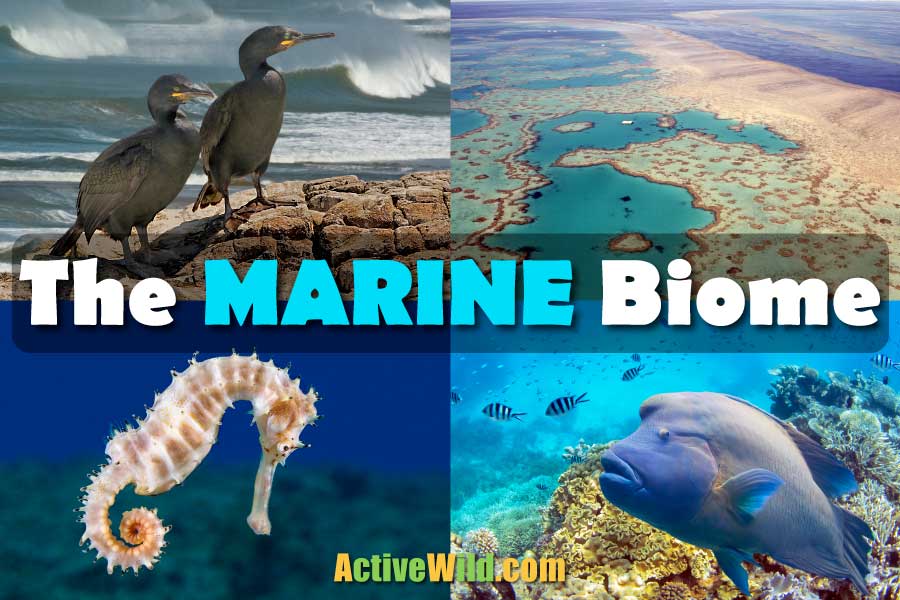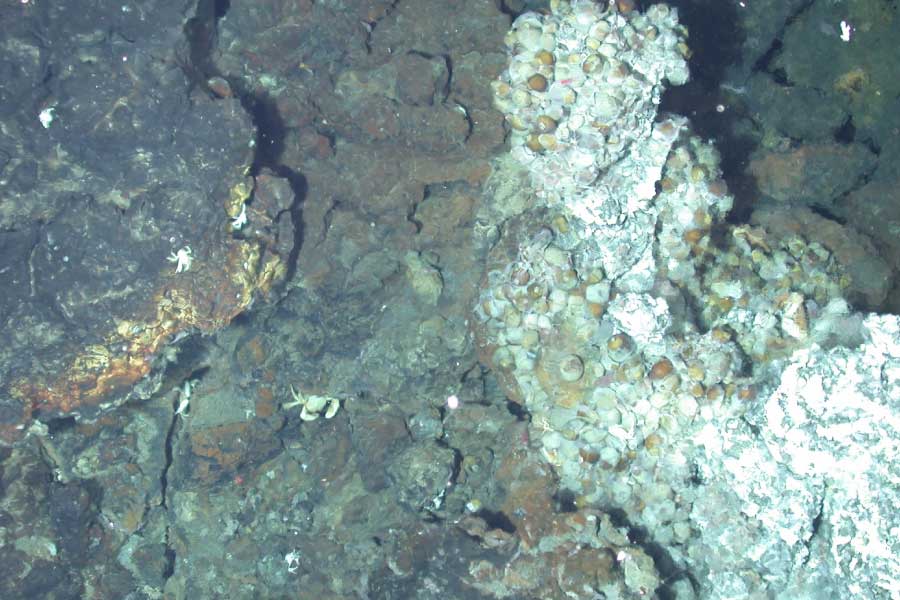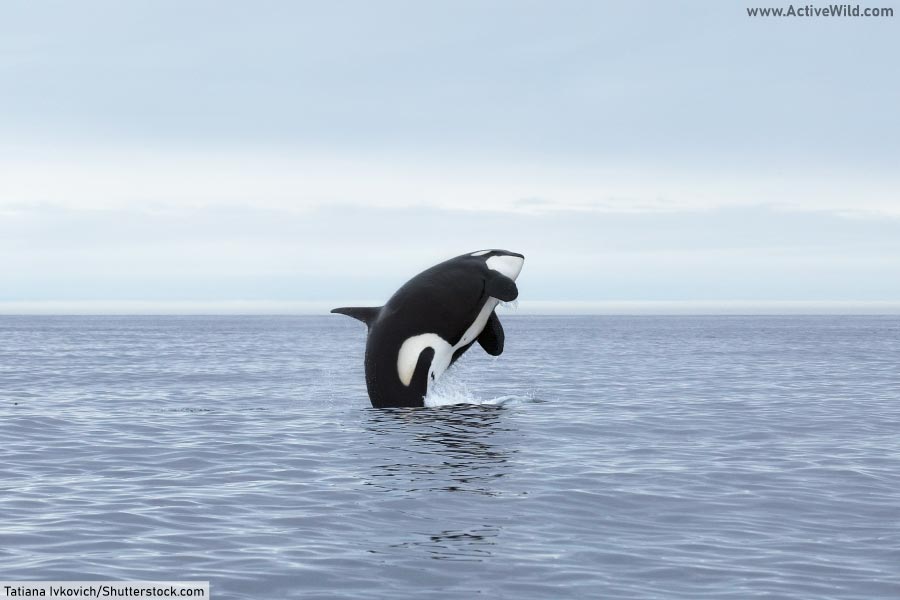The Marine Biome is the largest biome, and one of the most important in terms of biodiversity. On this page you’ll find an introduction to the marine biome and to the various ecosystems it contains.
The Marine Biome Page Index
- What Is The Marine Biome?
- Ocean Zones
- Ecosystems And Habitats
- Coral Reef Ecosystem
- Ocean Ecosystem
- Estuary Ecosystem
- Biodiversity Within The Marine Biome
- Threats To The Marine Biome
- Further Reading
What is the marine biome?
The marine biome is the world’s largest biome, covering three-quarters of the earth's surface. The types of ecosystems found in this biome are oceans, coral reefs, and estuaries; all are saltwater environments. There are five main oceans in the marine biome: the Atlantic, Pacific, Indian, Arctic, and Southern oceans. The marine biome also encompasses many gulfs and bays.
The marine biome supports a wide variety of organisms, and healthy oceans are also essential for life on land. Marine algae supply much of the world's oxygen and absorb a large amount of atmospheric carbon dioxide.
- You can find out more about ocean animals on this page: Ocean Animals List with Pictures & Facts
The average water temperature of the sea is around 39 degrees Fahrenheit (four degrees Celsius), but it can be colder or warmer based on several parameters, such as location and depth. The coldest ocean is the Arctic ocean, with an average temperature of 28 degrees Fahrenheit (-2.22 degrees Celsius).
Ocean Zones
The ocean is divided into three vertical zones, which are based on depth: the euphotic, disphotic, and aphotic zones.
The euphotic zone is the area where light can penetrate and where the vast majority of photosynthesis takes place. This zone is around 656 feet (200 meters) deep.
The middle layer is the disphotic or mesopelagic zone, also known as the ‘twilight zone’ of the ocean. This zone appears deep blue to black in color as less light can reach here.
The third layer is called the aphotic zone, and this layer is completely dark. It is also very cold and supports little life. This zone makes up approximately 80% of the ocean.
The deepest part of the ocean is the Mariana Trench, which is 36,200 feet (10,000 meters) deep, which is deeper than Mount Everest is tall!
- You can find out more about the Mariana Trench on this page: Mariana Trench Facts
Marine Ecosystems and Habitats
There are three main ecosystems found in the marine biome: the ocean, coral reefs, and estuaries. Each of these has several habitats that support varied marine life and are quite different in their characteristics.
Coral Reef Ecosystem
Coral reefs are extremely diverse and can be found all over the world, from tropical regions to those that are extremely cold.
Coral polyps are the animals that are primarily responsible for building the reefs. Thousands of coral species have been discovered, and they can take many forms, with some building large and colorful colonies, while others being more solitary and smaller in size.
Reefs form when the corals grow close to the shore. The majority of coral reefs are called fringe reefs because they fringe the coastline of either a continent or an island.
Corals are slow-growing, and so reefs take a long time to form. The fastest-growing coral grows at a rate of six inches (15 cm) per year, but most will grow less than an inch over 12 months.
The largest coral reef is the Great Barrier Reef, which is found off the east coast of Australia. It began growing 20,000 years ago and now spans 1,600 miles (2,600 km). It is so large that it can be seen from space!
- You can find out more about the Great Barrier Reef on this page: Great Barrier Reef Facts
While coral reefs cover less than 2% of the ocean floor, it is estimated that approximately 25% of all ocean species depend on coral reefs for food and shelter.
Many species also use coral reefs as nursery grounds to rear their young.
Ocean Ecosystem
The ocean ecosystem is the largest of the ecosystems found within the marine biome. It is split into four horizontal zones: intertidal, pelagic, benthic, and abyssal.
The intertidal zone is where the ocean meets the land, and it varies in appearance depending on its geographical location and the time of the day. This zone is sometimes submerged and sometimes exposed, as waves and tides come in and out.
In some regions, the intertidal zone is rocky. At the edge of this zone, rocks are usually exposed and are home to only a handful of algae and mollusks. The lifeforms become more diverse and more abundant on rocks that are usually submerged. This rocky area is home to algae and small animals, including snails, crabs, sea stars, and small fishes.
The bottom of the intertidal zone is only exposed on the lowest of tides and is home to larger fishes, seaweeds, and invertebrates. In contrast to the rocky shore, sandier shores are less diverse. The waves keep mud and sand continually shifting, which makes it difficult for plants and algae to establish themselves. This region is mostly home to worms, clams, crustaceans, crabs, and shorebirds.
The pelagic zone is further from the land and is home to many species of fish and some mammals, such as whales and dolphins.
This region is colder than the intertidal zone, and the temperature varies at different depths due to thermal stratification and the mixing of warm and cold currents. In this zone, the flora generally consists of surface seaweeds.
Below the pelagic zone is the benthic zone, which includes the sea floor. The bottom of this zone consists of sand, silt, and dead organisms. The temperature here is cold and decreases as the depth increases towards the abyssal zone, which is the deepest part of the ocean.
The benthic zone is nutrient-rich, and so supports a wide range of fauna, including bacteria, fungi, sea stars, marine worms, sea anemones, and fishes. The primary flora in this zone is seaweed.
The abyssal zone is the deepest zone and is often dark, as light can not penetrate this deep. As a result, the water here is very cold. It is also high in oxygen but low in nutrients.
Hydrothermal vents are found in the abyssal zone. These vents emit large amounts of hydrogen sulfide and other minerals that support several types of chemosynthetic bacteria. This, in turn, provides food for invertebrates and fishes.
Estuary Ecosystem
Estuaries form when salt water from the ocean mixes with fresh water from the land. Other names for estuaries include bays, lagoons, inlets, harbors, wetlands, sounds, and swamps, and they vary in size.
Estuaries are tidal, and experience changes not only associated with the mixing of fresh and saltwater, but also with the ebb and flow of the tide. The animals and plants that live here must therefore be adapted to cope with challenges associated with not only physical changes, such as the rise and fall of the tides, but also variations in water chemistry, such as salinity.
Despite these challenges, estuaries are one of the most productive ecosystems on earth. They are home to a wide array of flora and fauna, including fish, shellfish, crustaceans, marine worms, seagrasses, alga, plankton, and mangroves.
Numerous animals rely on estuaries for nesting and breeding grounds. Many species of shark use estuaries as an area to have their young. The young can use the estuaries for food and shelter until they are ready to swim out into the open ocean.
Biodiversity within the Marine Biome
- You can see a list of interesting marine animals on this page: Ocean Animals List with Pictures & Facts
The marine biome encompasses a range of habitats, and so it is no surprise that it is home to a vast array of plants and animals.
The marine food chain starts with the tiny phytoplankton – unicellular organisms such as algae that produce their own food via photosynthesis.
Phytoplankton is eaten by the larger zooplankton, shrimp, and other small animals. Next in the food chain are larger animals, including sedentary species such as corals and mollusks.
Above these are more mobile animals such as crustaceans, squids and jellyfish, eels, snakes, and fish. At the top of the marine food chain are the apex predators, which include killer whales and great white sharks.
The majority of life in the marine biome is found in the first 200 meters. At greater depths, less light can penetrate, and the population density quickly declines. There are, however, some organisms found at greater depths, including species of clams and marine worms.
The ocean is home to nearly 200,000 identified species, yet with the vast majority of the world's oceans remaining unexplored, the actual number of organisms living in the world’s oceans could be in the millions.
Threats to the marine biome
Climate change and pollution are some of the greatest threats to the marine biome.
Climate change is altering several characteristics of ocean habitats by increasing temperatures and acidification.
Rising temperatures can impact species on several levels, altering not only their distribution but also the distribution of their prey or the plants that they feed on. Fluctuating temperatures can also have detrimental effects on reproduction and development. Some species are disappearing altogether, such as certain species of coral that experience rapid bleaching as temperatures warm, which ultimately results in their death.
Pollution is also harming marine ecosystems. Plastic is one source of pollution with 8 million tonnes of plastic ending up in the oceans every year. To put this into some context, plastic pollution makes up 80% of all marine debris found throughout the water column. It causes several issues, as species ingest or become entangled in this debris, which can lead to severe injury or death.
Plastic pollution not only poses problems for marine life, but can also impact humans too. Microplastics, which are often invisible to the naked eye, have been found in tap water, beer, salt, and all water samples that are collected from the ocean.
Chemicals used in the production of plastic can interfere with several processes in the body of humans and wildlife and have also been shown to have carcinogenic properties.
Other impacts on the marine biome include over-fishing, pollution from agricultural and industrial effluents, and habitat destruction.
Many people rely on the oceans for food, for a source of income, and for recreation. Conservation and management plans need to address these issues so that we can ensure that our practices become sustainable in the long-term while minimizing impacts on nature.
Further Reading
You can find out more about the world's oceans, marine species and other biomes on the following pages:
- Ocean Animals: A List Of Animals That Live In The Ocean With Pictures & Facts – Plus FREE question sheet
- Fun Facts On Whales: Interesting Information On Whale Species, Ecology, Related Animals & Conservation
- Fun Facts On Sharks: Shark Facts, Information & Pictures
- Grasslands and the Grassland Biome: Facts, Pictures, Plants, Animals, Ecology & Threats
- The Tundra Biome Facts, Pictures & Information. Discover The World’s Coldest, Harshest Biome…
- What Is The Taiga Biome? Discover The Boreal Forests Of The Northern Hemisphere
- What Is An Ecosystem? Exploring Earth’s Terrestrial & Marine Ecosystems
Sources
- https://www.noaa.gov/education/resource-collections/marine-life/coral-reef-ecosystems
- https://ocean.si.edu/ocean-life/invertebrates/corals-and-coral-reefs
- https://niwa.co.nz/education-and-training/schools/students/estuaries#whatee
- https://www.iucn.org/resources/issues-briefs/marine-plastics
- https://www.marine.ie/Home/site-area/areas-activity/education-outreach/marine-biodiversity?language=en
- https://www.worldatlas.com/articles/which-ocean-is-the-warmest.html
- https://www.britannica.com/science/disphotic-zone









